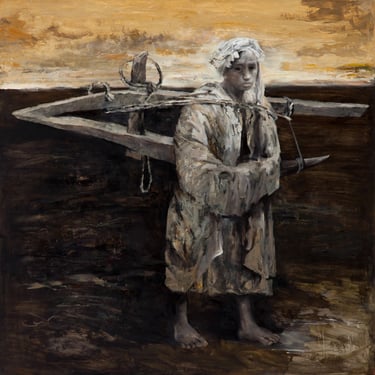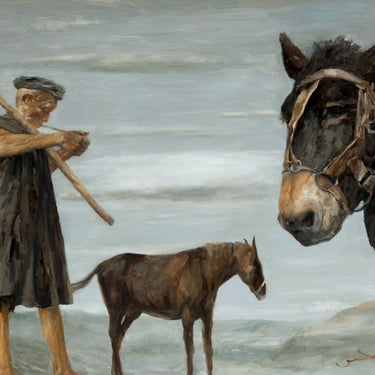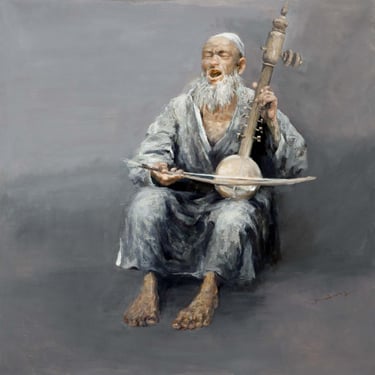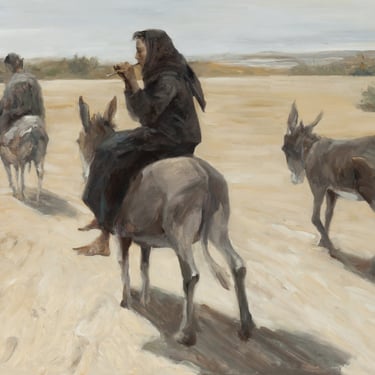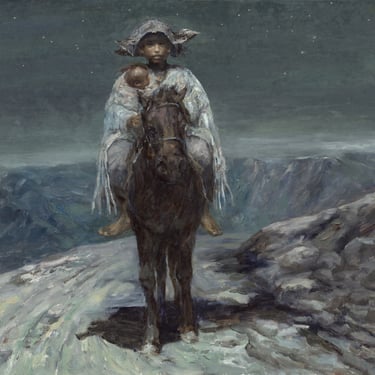Fusion of Heart and Art, Unity of Self and Object
Author | Zhou Yimin
10/1/2014
A Critical Review of Cen Long’s Art
In my impression, Cen Long is not only a devoted pioneer who regards art as life itself, but also a profoundly learned mentor, a kind-hearted friend, a man of resilience, and a natural-born artist. As early as the 1970s and 1980s, his works were frequently selected for the National Popular Science Art Exhibition, the China Oil Painting Exhibition, and the Seventh National Art Exhibition, where he first gained recognition for his exceptional talent and technical mastery in the field of oil painting.
Like many artists born in the 1950s, Cen Long was shaped by a cultural landscape dominated by Western realism. However, what sets him apart is the turbulent and arduous journey he has undertaken. He has experienced life in remote mountains and rural villages, served in the military (though never in combat, as his artistic talent led to his recruitment as a cultural officer), and endured years of wandering. During the Cultural Revolution, his parents were denounced as reactionary intellectuals and imprisoned, leaving Cen and his younger brother to fend for themselves as drifters.
Yet, amid hardship, one thing remained constant—his love for painting. From an early age, he was immersed in artistic influence, absorbing the discipline naturally. His father, Cen Jiawu, was among China's most esteemed anthropologists, ethnologists, and art scholars. During his studies in Japan in the 1930s, he authored A History of Totem Art, a pioneering work that laid the foundation for Chinese art anthropology. Even today, it remains an essential reference in the field. Clearly, Cen Long’s lifelong dedication to art is inseparable from his father’s legacy.
Criticism of Cen Long’s oil paintings is, as always, subjective and multifaceted. As the saying goes,
“There are a thousand Hamlets in a thousand readers’ eyes.”
For me, while I cannot claim to be like Confucius, who, upon hearing Shao music, was so enraptured that he lost his appetite for three months, I am nevertheless deeply moved by the profound elegance and boundless emotion embedded in Cen Long’s art—an experience that lingers long after the viewing.
In essence, I believe the power of his work lies in three distinct qualities:
Transcending Skill and Utility—Mastery as a Path to Meaning
Serene, Introspective, and Pure—A Return to Authenticity
Fusion of Heart and Art, Unity of Self and Object
It is evident from Cen Long’s paintings that he has never ceased his exploration and refinement of oil painting techniques. Even in the 1990s, when the influence of Western contemporary art led many artists to abandon technical rigor in favor of pop art tailored to mass consumption, Cen Long remained steadfast in his pursuit of artistic depth. While some of his contemporaries reaped fame and fortune, and others became art tycoons, these external forces never wavered his commitment.
For decades, he has devoted himself to meticulous study and relentless practice, moving from early art catalogues to immersive study in Japan and Europe, where he examined original masterpieces of past masters. His inquiry extends from painting tools and materials to color, line, composition, and structure, down to the most intricate details of brushstroke transitions and pictorial rhythm.
To him, every aspect of painting technique must be pushed to its limits, refined to an uncompromising standard. He is driven by a belief akin to the poetic ethos:
“If my words do not startle the world, I shall not rest.”
After all, without mastery of technique, how can one create meaningful art? Without the skin, what can the hair attach itself to?
Cen Long’s commitment to technique has enriched his artistic expression, elevating his work to a distinctive and deeply personal aesthetic.
If Shang Yang is recognized for his pioneering use of yellow tones in Chinese oil painting, then Cen Long must be acknowledged as one of the most sophisticated masters of the gray palette. The deliberate use of gray tones in his works imbues them with a quiet, introspective depth, shaping an artistic language that is both unembellished and profoundly moving.
His paintings do not rely on dramatic spectacles or grand narratives, yet they convey a poignant and enduring power. Within them, one can sense his concern for the moral erosion of modern civilization, his profound grief for loved ones lost, and his endless quest for human truth and spiritual belonging.
Fusion of Heart and Art, Unity of Self and Object
One of the defining characteristics of Cen Long’s paintings is his deep emotional and spiritual engagement with his subject matter. Although he employs traditional figurative techniques, his works are not merely representations of what he sees—they are expressions of what he feels.
He does not paint the world as it appears, but as it resonates within him. In this sense, his work transcends mere realism; it is a fusion of loneliness, sorrow, and existential contemplation, distilled into a visceral and spiritual reality.
In the same way that Caravaggio sought redemption through the brutal honesty of his self-portraits, Cen Long builds a bridge between reality and the ideal—a space where both his spirit and body may find sanctuary and purpose.
His paintings are not merely images; they are testimonies of the soul.
A Legacy of Artistic Integrity
In an era where artistic trends shift rapidly, Cen Long remains unwavering. He does not chase contemporary relevance, nor does he concern himself with whether his work fits the mold of modernity.
And yet, his paintings are deeply contemporary in essence. Through his subtle yet potent narratives, he raises questions about suffering, survival, land, eternity, centrality and marginality, ethnicity, nationalism, transcendence, and the human condition. His work expresses a profound and enduring humanism, a concern for the elevation of the soul—something that remains scarce in contemporary China.
His paintings may vary in appearance, but their inner essence remains constant—imbued with profound empathy, melancholic yet never despairing. His art is a long, unbroken sigh—the voice of an ancient civilization grappling with the complexities of the modern world.
I have not analyzed individual paintings here, nor do I wish to. Instead, I invite the viewer to enter his work—for in doing so, you will step into the artist’s life itself. And if you truly listen, you may find echoes of your own existence, and perhaps, the fate of a people long in search of home.
